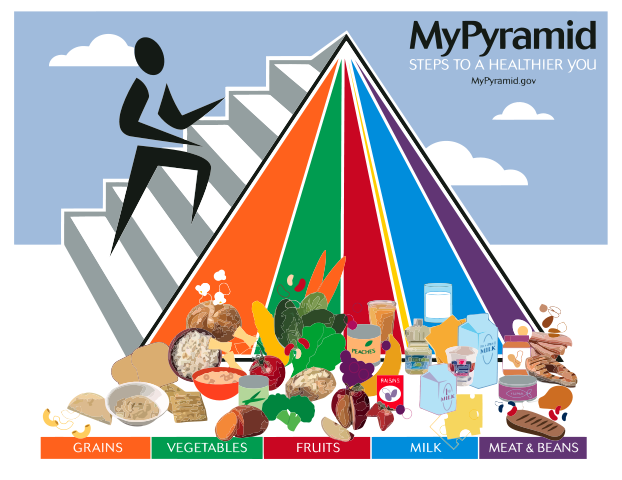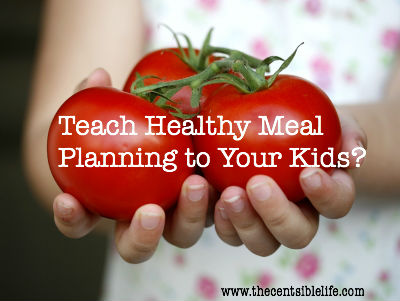I come across comments like these all of the time, “There is no way my kids would eat that,””that”being something healthy, and “you can’t eat healthy on a budget.”But the fact of the matter is kids will eat “that”if they are given no other choice, and you can help them eat “that”all while staying with in your family’s food budget. All it takes is a little education so that you can teach healthy meal planning to your kids. Here’s how.
Meal Planning Step One: Teach the food pyramid.
The first step to healthy meal planning is to understand what a healthy eating looks like. Here’s the food pyramid from My Pyramid.gov.

Looks complicated right? Too complicated for kids? I agree. Instead I prefer this graphic.
I find it to be easier to understand portion size when you are looking at this graphic. But with whichever one you prefer, introduce the food pyramid to your kids.
Once you have done that step, have them list all of the foods that they love from each category. You could get really creative and have them cut out pictures of the foods, or talk about recipes that include those foods, etc. But however you do it it is really important that you have them come up with foods they they love from each category.
**Bonus Tip– Corn is a grain not a vegetable.
Meal Planning Step 2: Teach them the amount of food they need from each category.
Like with adults at various ages, kids at various ages have different dietary requirements, and to teach healthy meal planning properly the meal planner needs to understand these requirements. The American Heart Association has a wonderful spreadsheet that tells you exactly how much of each food category your kids should be getting. Take the time to discuss with your kids what they should be eating on a daily basis. This was quite the eye opener for my kids.
Once you become aware of what they should be getting daily teach them about serving sizes. My kids learn best by hands on techniques or techniques that allow them to visualize what I am talking about. For example I’ve taught them that ½ a cup of cooked rice is equal to a tennis ball. For more ways to help your kids visualize serving sizes check out this handout from McKinley Health Center.
Meal Planning Step 3: Teach them to build a budget friendly grocery list.
Now that your kids have a understanding regarding what healthy eating should look like, and they have listed what foods they love from each food category, you can begin the part in which you teach them meal planning on a budget.
Part of budget friendly meal planning involves building your grocery lists around the grocery sales happening in your local grocery stores. Save your weekly sales flyers from local grocery stores, have your discounts sites online bookmarked, and teach your kids how to treasure hunt for those budget friendly grocery items. Have them look for all of their favorite foods within those flyers. From there your kids can build their own specialized grocery list, filling in where necessary from non-sale items that are budget friendly. (You will have to teach them which are those items.)
If you want to take the treasure hunt one step further your kids can invent their own special recipes that includes the foods that they love. Let your kids take ownership of this step by allowing them to get super creative. For example one of my kids favorite meals is Meat Balls with Spaghetti Squash and Tomato Sauce. But rather than calling it Meatballs with Spaghetti Squash and Tomato Sauce, my son nick-named the recipe Dirt Balls with Bloody Worms. What can I say? Boys are gross.
Negotiate for the bonus treasure.
There are going to be food items within your sales flyers that you would like your kids to try that they won’t want to try. There will also be things on those flyers that you won’t want them to have. Now is the time to negotiate. I offer my kids a serving per serving bonus treasure option. They eat without whining one solid serving (not one bite…one serving) of what I want them to try. Then they can eat without mom or dad complaining one solid serving of whatever fascinating junk they desire. Through this process my kids have discovered foods that they may otherwise have thought disgusting as being actually quite delicious.
**Bonus Tip – The key is no whining. I’m not going to spend 1 hour coaxing my whiney kid along trying to talk them into eating something. They know the deal. They eat my bonus treasure food in a timely manner without whining, and they get their bonus treasure food. If they start to whine, I take my bonus treasure food away very calmly (I don’t get caught up in their drama), and the deal is over. They only had to have that happen a couple of times, and they got the clue. It’s really pretty simple.
One Final Note
My pediatrician a long time ago told me that kids instinctively will not let themselves starve. And the key to getting them to eat healthy while they are living and growing under your roof is to stand strong, only offering healthy options and understanding that eventually their need for food will override their need to be stubborn about what they eat. For me this is the hardest part about Teaching Healthy Meal Planning to Kids, having the where with all to stick to my guns in regards to what they put in their mouths. And yes there are times that I fail and give in to the begging for burgers and fries. However, for the most part my kids know that burger and fries are the exception not the rule. And when I, for example, offer up a vegetable laden salad for dinner my kids seldom tell me, “I’m not eating that.â€
Kelly Kinkaid
Image: FreeDigitalPhotos.net


I also encourage my kids to help me in the kitchen. They don’t always want to eat the food they help prepare, and that’s okay. However, I think they feel more connected to the process, and not so forced to eat stuff they don’t like (which probably isn’t coming out the way I meant it).